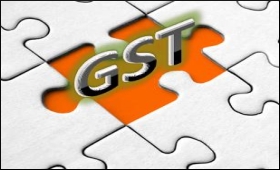|

|
One nation + one tax = Rs 9.20 lakh cr for GST
|
|

|
|
| Top Stories |
 |
|
|
|
IANS | 16 Aug, 2016
About 42 percent of the Rs 22 lakh crore (USD 328 billion) revenue of the central government and 35 states and union territories will now be subsumed under the goods and services tax (GST), passed by parliament's upper house on August 3, 2016 and being touted by some as one of independent India's "boldest reforms".
Around Rs 9.20 lakh crore (USD 137 billion) of Central and state revenue from 15 taxes --from Central Excise to levies on gambling -- in 2014-15 (USD 1 = Rs 67) will be brought under the GST, scheduled to be levied from April 1, 2017, although the government might be hard-pressed to make this deadline.
Industries and commercial enterprises currently pay various taxes at various stages of a product or service, such as manufacture, transport, wholesale, logistics and retail. The administration of these taxes is often tangled in paperwork, results in slow inter-state movement of products and increases costs for consumers.
Most of these taxes will be subsumed by the GST, barring a few, such as those on vehicles, roads, property and electricity.
The law enabling the GST must now go back to the the Lok Sabha, which must clear the new amendments brought in by the government to get political consensus, after which it must be ratified by half of all state legislatures.
Simultaneously, the information technology backbone that the GST will require is getting ready, with software testing set for October 2016, the Economic Times reported on August 3, 2016.
Hard to implement, but basic design is ready
It isn't yet clear what the GST taxation rate will be, but 17 percent to 18 percent is likely. Implementing the GST will not be easy because many taxes and their administration must be disentangled and brought online into a single, nationwide system. However, the basic architecture of such a system has been created.
As that nationwide system is constructed and brought online, tax administrators will also have to be retrained.
"For effective implementation of GST, tax administration staff -- both at the Central and state levels -- would require to be trained properly in terms of concept, legislation and procedure," Karthik S and Satish Dedhia, tax experts at the PriceWaterhouseCoopers consultancy, wrote in Forbes India in February 2016. "The tax administration staff would also need to change their mindset, approach and attitude towards the tax payers. And for this, they would have to 'learn, unlearn, and relearn' the GST not only in letter but in spirit too."
A GST Council will control the new tax regime across the Centre and the states; it will fix tax rates, exemptions and other issues. The Centre's representatives will control a third of the vote in the council.
Two Central representatives (Finance Minister and Minister of State for Finance) account for 33.3 percent of the vote, while 29 finance ministers account for the remaining 66.7 percent, according to the 122nd Constitutional Amendment Bill that will give effect to the GST regime.
Balancing act ahead, but calculations for UP, Maharashtra show it can work
The key challenge for the central government is to ensure both the Centre and the states benefit from the GST -- in other words, get as much as or more money than they currently do.
The Centre is likely to compensate states for lost revenue on Ãâgoods' by increasing their share of taxes on services, according to an analysis by the Institution of Chartered Accountants of India (ICAI).
Indian states cannot afford to lose revenue because they are already in debt, as IndiaSpend reported.
Maharashtra, India's most industrialised state, and Uttar Pradesh (UP), the most populous, expect to get at least Rs 60,000 crore and Rs 65,000 crore per year, as IndiaSpendÃâs calculations revealed in December 2015. We found that these figures, based on data from the Reserve Bank of India's Study of State Finances, are almost equal to the revenue Maharashtra and UP currently receive through a host of taxes, which the GST will replace.
We chose Maharashtra for the analysis because it is the state with highest revenue from its own taxes, as a share of total revenue, at 66 percent; and UP because it has the highest total revenue but no more than 36 percent from its own taxes.
(In arrangement with IndiaSpend.org, a data-driven, non-profit, public interest journalism platform. Feedback at respond@indiaspend.org)
|
|
|
| |
|
|
|
|
|
|
|
GST and impact on Imported goods
Arvind | Wed Aug 17 09:34:20 2016
The article is very informative. However, could your team share its impact on Imported goods such as parts of machinery, robots etc.

GST
Rizwan | Wed Aug 17 04:29:31 2016
Its is certainly informative ... please highlight and educate us on some more taxation issues related to GST especially covering Excise Duties..

|
|
|
|
|
|
|
| |
| Customs Exchange Rates |
| Currency |
Import |
Export |
US Dollar
|
84.35
|
82.60 |
UK Pound
|
106.35
|
102.90 |
Euro
|
92.50
|
89.35 |
| Japanese
Yen |
55.05 |
53.40 |
| As on 12 Oct, 2024 |
|
|
| Daily Poll |
 |
 |
| Do you think Indian businesses will be negatively affected by Trump's America First Policy? |
|
|
|
|
|
| Commented Stories |
 |
|
|
|
|
|
| |
|